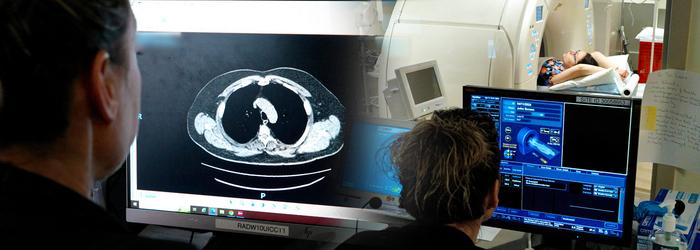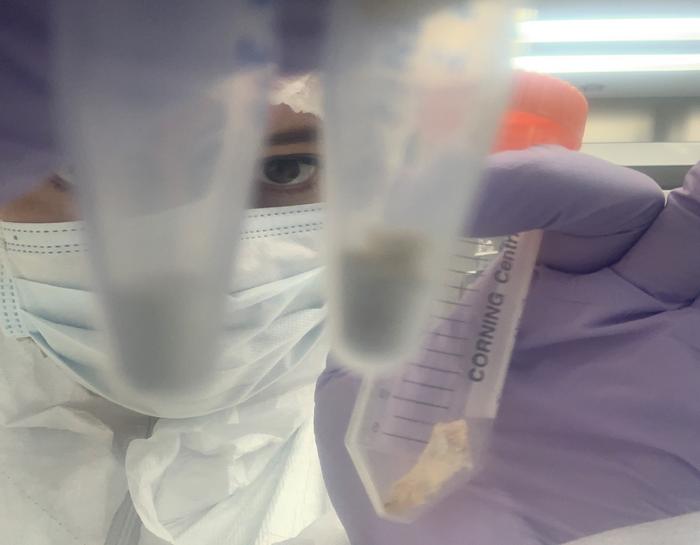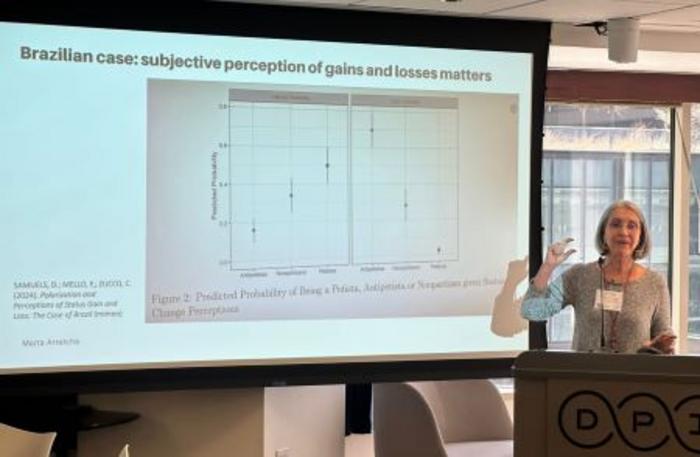University of Maryland Greenebaum Comprehensive Cancer Center and AstraZeneca partner to enhance community-based lung cancer screening and detection for Marylanders at high risk
With only a small percentage of Marylanders at high risk for lung cancer getting the recommended annual screening, the University of Maryland Marlene and Stewart Greenebaum Comprehensive Cancer Center (UMGCCC) launched a new statewide effort to increase annual screenings. Credit: University of Maryland School of Medicine With only a small percentage of Marylanders at high risk for […]

With only a small percentage of Marylanders at high risk for lung cancer getting the recommended annual screening, the University of Maryland Marlene and Stewart Greenebaum Comprehensive Cancer Center (UMGCCC) launched a new statewide effort to increase annual screenings.

Credit: University of Maryland School of Medicine
With only a small percentage of Marylanders at high risk for lung cancer getting the recommended annual screening, the University of Maryland Marlene and Stewart Greenebaum Comprehensive Cancer Center (UMGCCC) launched a new statewide effort to increase annual screenings.
The partnership also includes the University of Maryland Medical Center (UMMC), where the cancer center is located, the University of Maryland School of Medicine (UMSOM), the University of Maryland Medical System (UMMS), and the University of Maryland, Baltimore (UMB).
This public-private initiative, with up to $8 million in funding from AstraZeneca over the next five years, aims to enhance community-based cancer screening and early detection, leading to earlier diagnosis and more treatment options for patients.
“We want to ensure that all eligible Maryland residents undergo timely and cost-effective lung cancer screening,” said Taofeek Owonikoko, MD, PhD, Executive Director of UMGCCC, a National Cancer Institute (NCI)-designated comprehensive cancer center within UMMC. He is also the Marlene and Stewart Greenebaum Professor of Oncology at UMSOM. “Early detection can have a bigger impact on a patient’s chances of survival from lung cancer than chemotherapy or immunotherapy, yet only a few are advocating for it.”
The initiative aims to provide greater access to screening, particularly in underserved communities.
This partnership seeks to address:
- Strengthening and expanding lung cancer screening programs and tobacco cessation efforts across the State.
- Evaluating innovative and alternative approaches to improve early detection efforts among at-risk populations.
- Harnessing technology to identify patients at risk, and those eligible for screening.
- Ensuring timely and systematic sharing of scalable successes and lessons to drive public policy, and guide screening efforts in other cancer types beyond lung cancer and beyond Maryland.
- Establishing a “Center for Cancer Health Equity” and a personalized cancer early detection and interception clinic model, to drive research in cancer health disparities with an emphasis on Maryland minority and rural communities.
As part of the initiative, the University of Maryland Institute for Health Computing (UM-IHC) and the State Health Information Exchange, called CRISP, seeks to leverage cutting-edge technologies to better understand the large population of screening-eligible patients and to develop innovative, cost-effective models for improved cancer prevention.
In widely accepted guidelines, the US Preventive Services Task Force recommends annual lung cancer screening with a low-dose CT scan for individuals ages 50 to 80 who have smoked a pack a day for 20 years and currently smoke or have quit smoking within the past 15 years. Lung cancer is the leading cause of cancer deaths in Maryland as well as in the U.S. It is frequently detected in the later stages after it has already spread. Smoking is a key risk factor, including for people who no longer smoke. Exposure to carcinogens like radon, second-hand smoke, or excess air pollutants can also raise a person’s risk.
While many Maryland residents are at high risk for developing lung cancer, very few are receiving screening services. Based on a preliminary analysis by AstraZeneca, Baltimore County, together with the city of Baltimore, ranks in the top counties in the U.S. for lung cancer risk. Ten additional counties in Maryland, including Montgomery, Howard, and Prince George’s, all have higher rates of lung cancer than the national average even though their smoking rates fall below the national rate.
“Low-dose CT screening can reduce lung cancer mortality by 20 percent in those at high risk, yet only about 3 percent of those who are eligible for screening are actually getting annual low-dose CT scans in Maryland, which is significantly lower than the national average,” said Dean Mark T. Gladwin, MD, who is the John Z. and Akiko K. Bowers Distinguished Professor and Dean of UMSOM, and Vice President for Medical Affairs at University of Maryland, Baltimore. “As a practicing pulmonary and critical care specialist, I have witnessed the devastating impact of lung cancer on my patients’ lives, and as Dean of our medical school’s faculty physicians, I embrace our unique opportunity and responsibility to bring lung cancer screening to all the citizens of Maryland.”
The low lung cancer screening rate of just 3 percent compares to an estimated 83 percent of women in Maryland, ages 50 to 74, who receive annual mammograms to screen for breast cancer, according to data from the NCI.
Addressing racial disparities in detecting and treating lung cancer will be a key part of this effort. Black patients with lung cancer are 15 percent less likely to be diagnosed early and are 16 percent less likely to survive five years after diagnoses compared to white patients, according to the latest data from the American Lung Association.
“The message is simple: Lung cancer screening saves lives,” said Bert W. O’Malley, MD, President and CEO of UMMC who is a practicing head and neck cancer surgeon. “It’s our single greatest weapon against this deadly condition. That’s why it’s so vitally important that we work to remove the barriers that prevent thousands of at-risk Marylanders from getting screened. This partnership will help improve the health and well-being of the community we serve.”
Mohan Suntha, MD, MBA, President and CEO of UMMS, noted that UMMC and five member organization hospitals within UMMS currently offer low-dose CT lung cancer screening. “We are excited to have additional locations within the University of Maryland Medical System join this initiative, which will expand and integrate our existing community screening efforts. Because of the scale and reach of our system, we will be able to reach Marylanders statewide, particularly those in communities at greatest risk,” said Dr. Suntha, who is also the Marlene and Stewart Greenebaum Professor of Radiation Oncology.
The other five UMMS hospitals that offer low-dose CT lung cancer screening are University of Maryland Baltimore Washington Medical Center in Glen Burnie, University of Maryland St. Joseph Medical Center in Towson, University of Maryland Upper Chesapeake Medical Center in Bel Air, University of Maryland Capital Regional Medical Center in Largo, and University of Maryland Shore Regional Health in Easton.
A steering committee of academic, industry and community partners will be established to help guide the effort. Dr. Owonikoko will manage and coordinate the project. He previously served as a paid medical advisor to AstraZeneca. He has not served as a paid consultant to the company since beginning his position at UMGCCC. He has two investigator-initiated clinical trials supported by the company.
“AstraZeneca is committed to eliminating lung cancer as a cause of death and we know that achieving that bold ambition begins with early detection and diagnosis,” said Mohit Manrao, SVP and Head of U.S. Oncology at AstraZeneca. “We’re pleased to partner with the Greenebaum Comprehensive Cancer Center to expand critical services to at-risk Marylanders, especially those in underserved communities.”
After the initial launch of the lung cancer screening effort, officials plan to expand the project to include breast, cervical and colon cancer screening within a few years.
“We want to bring everything that we learn through this partnership over the next five years to the wider oncology community, to say, ‘This is how we did it in Maryland. These are the lessons learned. If you want to do it, here is the recipe for you to do it,” said Dr. Owonikoko, a nationally recognized thoracic oncologist who specializes in treating patients with lung cancer. He was recently named a Cancer Equity Leader by the NCI.
What's Your Reaction?

































